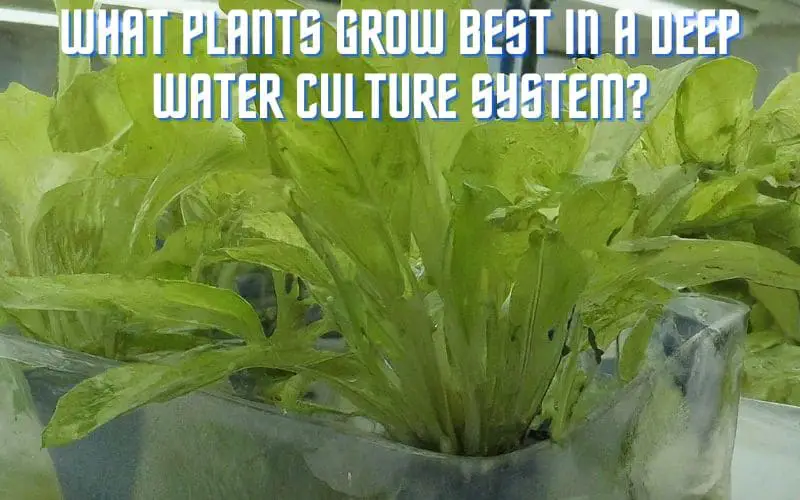What Plants Grow Best In A Deep Water Culture System?

Introduction
Welcome to the comprehensive guide on deep water culture systems for plant growth. In this article, we will explore the benefits of this hydroponic system, the best plants suited for it, how to set it up, and the value it brings to plant cultivation. Whether you’re a beginner or an experienced gardener, this in-depth discussion will provide valuable insights into maximizing plant growth through a deep water culture system.
Answer to the Question
The deep water culture system is conducive for various plants including leafy greens, herbs, fruiting plants, and flowering plants. The system offers increased nutrient uptake, enhanced oxygenation, and improved growth rates, making it an ideal choice for cultivating a wide range of plants.
Benefits of Deep Water Culture System for Plant Growth
Increased Nutrient Uptake
Deep water culture (DWC) system plays a pivotal role in ensuring plants receive an ample supply of essential nutrients for their growth and development. This system allows for direct and uninterrupted access to nutrients, facilitating their efficient uptake and utilization by the plants. The constant availability of essential nutrients promotes robust root development and overall plant health.
- Oxygenation: The oxygenation of nutrient solutions in DWC systems creates an optimal environment for nutrient absorption by the roots. Well-oxygenated nutrient solutions facilitate the efficient uptake of nutrients, supporting healthy plant growth.
- Root Health: The DWC system encourages the development of strong and healthy root systems. Well-established roots are essential for the effective uptake of nutrients, ensuring that plants receive the nourishment they require for robust growth and productivity.
- Optimal Nutrient Ratios: Maintaining the correct balance of essential nutrients in the DWC system is crucial for promoting efficient nutrient uptake. The availability of balanced nutrient solutions ensures that plants receive all the elements required for their growth and development.
Furthermore, the direct delivery of nutrients to the roots in a DWC system circumvents potential losses that may occur in traditional soil-based systems, resulting in higher nutrient uptake and utilization. This enhanced nutrient uptake fosters well-nourished, vibrant, and productive plants, making the DWC system an ideal choice for growers seeking to maximize the nutrient efficiency of their cultivation practices.
Enhanced Oxygenation
- The deep water culture system maintains high levels of dissolved oxygen in the nutrient solution, creating a highly oxygenated environment for plant roots.
- This oxygen-rich setting stimulates root growth and boosts the plant’s overall respiratory functions, contributing to robust and thriving plant development.
- Increased oxygenation leads to improved efficiency in nutrient absorption, promoting healthier and more vigorous plant growth.
- The enhanced oxygenation also aids in preventing the development of anaerobic conditions, reducing the risk of root diseases and promoting a healthier root system.
Improved Growth Rate
By providing a constant supply of water and nutrients directly to the roots, the deep water culture system accelerates the plant’s growth rate. This consistent access to essential elements fosters rapid and substantial growth, resulting in healthier, more productive plants.
Best Plants for Deep Water Culture System
Leafy Greens
Leafy greens, such as lettuce, kale, and spinach, are excellent choices for deep water culture systems. Their ability to thrive in this environment is attributed to the direct access to nutrients and oxygen, which ultimately promotes lush foliage and robust growth. Let’s dive deeper into the benefits and variations of leafy greens in deep water culture:
- Benefits of Leafy Greens in Deep Water Culture:
- Nutrient-Rich Foliage: Leafy greens are known for their dense nutrient content, and in a deep water culture system, they can fully capitalize on the direct access to essential elements.
- Fast Growth: These plants are well-suited for rapid growth in a deep water culture setup, allowing for continuous harvest and propagation.
- Adaptability: Different varieties of leafy greens, such as arugula, Swiss chard, and bok choy, can be cultivated in the same system, providing a diverse range of produce.
- Varieties of Leafy Greens:
- There is a wide array of leafy greens that can thrive and yield exceptional results in a deep water culture system. Some popular choices include:
- Lettuce Comes in various types such as romaine, butterhead, and loose-leaf, offering diverse flavors and textures for culinary use. Kale Known for its robust leaves and rich nutritional profile, kale is a staple in healthy diets and culinary creations. Spinach Delicate yet nutrient-packed, spinach is an ideal leafy green for deep water culture, providing versatility in salads, smoothies, and cooked dishes.
With the exceptional adaptability and thriving nature of leafy greens in deep water culture, these greens serve as a captivating addition to any hydroponic garden, offering a fresh and nutrient-rich supply of produce.
Herbs
- Basil
- Mint
- Cilantro
Herbs, such as basil, mint, and cilantro, are exceptionally well-suited for deep water culture systems due to their ability to thrive in oxygen-rich and nutrient-dense environments. The controlled hydroponic setup provides an ideal platform for these herbs to flourish, resulting in a bountiful yield of fragrant and flavorful leaves.
Key Points about Herbs in Deep Water Culture:
- These herbs benefit from the direct access to water and nutrients, allowing for rapid and robust growth.
- The continuous flow of oxygen through the water ensures that the herbs remain healthy and vibrant.
- The absence of soil reduces the risk of diseases and pests, promoting a clean and sustainable herb-growing environment.
Fruiting Plants
Fruiting plants, such as tomatoes, peppers, and cucumbers, are excellent candidates for a deep water culture system due to their robust growth and high productivity. The system’s efficient nutrient delivery and oxygenation create an ideal environment for fruiting plants to thrive. Here are some essential considerations and tips for cultivating fruiting plants in a deep water culture setup:
- Plant Selection: Choose high-quality, disease-resistant varieties of fruiting plants to ensure a successful harvest. Popular choices include beefsteak tomatoes, bell peppers, and English cucumbers.
- Nutrient Requirements: Fruiting plants have specific nutrient needs during different growth stages. It’s crucial to maintain optimal nutrient levels by using a balanced hydroponic fertilizer tailored for fruiting crops.
- Support Systems: Install sturdy trellises, cages, or stakes to support the weight of fruit-laden branches and vines. Proper support prevents stem breakage and ensures the healthy development of fruit clusters.
- Pruning and Training: Regular pruning and training help manage the growth of fruiting plants, promote air circulation, and enhance light exposure to lower foliage, fostering uniform fruit development.
- Pollination: In a controlled indoor environment, hand pollination might be necessary for certain fruiting plants, such as tomatoes, to facilitate fruit set and maximize yields. Shake the flowering clusters gently to disperse pollen.
- Harvesting Techniques: Employ proper harvesting practices to gather mature, flavorful fruits. Use sanitized cutting tools to prevent the spread of diseases and handle fruits delicately to avoid damage.
Flowering Plants
Flowering plants, such as orchids, African violets, and marigolds, thrive in a deep water culture system due to the optimal conditions it provides. Here are some expanded details:
- Orchids: Orchids are epiphytic plants that naturally grow on tree branches and are known for their exquisite and diverse blooms. When cultivated in a deep water culture system, orchids benefit from the continuous supply of water, nutrients, and oxygen, resulting in healthy foliage and vibrant flowers.
- African Violets: African violets are beloved for their delicate, velvety leaves and a plethora of charming blossoms. In a deep water culture setup, these plants experience enhanced root health, leading to prolific flowering and lush greenery.
- Marigolds: With their cheerful, golden blooms, marigolds are a popular choice for gardeners. When grown in a deep water culture environment, marigolds flourish with robust stems, vibrant flowers, and prolonged flowering periods.
Additionally, implementing a deep water culture system for flowering plants fosters balanced nutrient uptake, efficient oxygenation, and optimal hydration. This method ensures the successful cultivation of various flowering plants, resulting in stunning blooms and vigorous growth.
Setting Up a Deep Water Culture System
Choosing the Right Container
Material: Consider the material of the container. It should be sturdy, non-toxic, and able to resist corrosion from the nutrient solution.
- Size: The container should be large enough to accommodate the plant’s root system and the nutrient solution. It should also have some room for the roots to grow and expand.
- Lid: If using a reservoir, a lid is essential to prevent light from reaching the nutrient solution, which can lead to algae growth and contamination.
- Accessibility: Ensure that the container allows for easy access to the root system for inspection and maintenance.
When setting up a deep water culture system, the choice of container is crucial to the success of the plants. An appropriate container provides a stable environment for the roots and the nutrient solution, promoting healthy growth and vibrant plant development.
Selecting the Appropriate Plants
When selecting plants for hydroponic cultivation in a deep water culture system, it’s important to consider a variety of factors to ensure successful growth and productivity. Here’s a detailed guide to help you choose the most suitable plants:
- Look for plants that are well-adapted to hydroponic cultivation and can thrive in a water-based environment.
- Consider the specific requirements of the plants, such as light, temperature, and pH levels, to ensure optimal growth within the hydroponic setup.
- Research plant varieties that are known to perform well in deep water culture systems, such as lettuce, spinach, and herbs.
When selecting plants for your hydroponic system, it’s essential to choose varieties that are well-suited for the deep water culture method. Consider the following factors to optimize plant selection:
- Adaptability: Look for plants that have demonstrated adaptability to hydroponic conditions and can thrive in a water-based environment.
- Growth Requirements: Understand the specific light, temperature, and pH needs of the plants to provide an ideal growing environment.
- Productivity: Select plant varieties that are known for their high productivity and yield in hydroponic setups.
By carefully considering plant suitability and optimizing your selection, you can ensure the successful growth of your hydroponic plants in a deep water culture system.
Maintaining Water Quality
- Regularly monitor and maintain the water quality in the deep water culture system to ensure that it remains well-oxygenated and free from harmful pathogens.
- Proper water quality management is essential for sustaining healthy plant growth and preventing any detrimental effects on the cultivated plants.
- Test the pH levels of the water to ensure it remains within the optimal range for hydroponic plant growth. Consider using pH up or pH down solutions to adjust the pH level if necessary.
- To ensure that the electrical conductivity (EC) of the water it is at the appropriate level for the plants we must check it. Adjust the EC level as needed using appropriate solutions.
- Regularly inspect the water for any signs of algae growth, and take necessary measures to prevent and control algae to maintain water clarity and quality.
Monitoring Plant Growth
Consistently observing and tracking the growth of the plants in the deep water culture system is essential for ensuring successful cultivation. Monitoring plant growth allows for timely adjustments and interventions to optimize the growing conditions and ensure healthy development.
- Regularly measure the height and width of the plants to track their progress.
- Observe the color and texture of the leaves to assess their health and nutrient uptake.
- Monitor the root system to ensure proper growth and development within the water culture system.
Conclusion
This system offers an array of benefits for plant growth and it provides an effective method for cultivating various plants. With the right setup and plant selection, this system can yield exceptional results, fostering healthy, vigorous growth and high-quality harvests. When we embrace this system plant new horizons in hydroponic cultivation open up. Now we can maximize the potential of our green endeavors.
